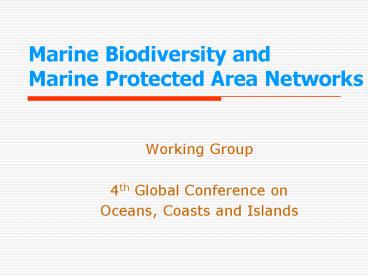Marine Biodiversity and Marine Protected Area Networks PowerPoint PPT Presentation
1 / 14
Title: Marine Biodiversity and Marine Protected Area Networks
1
Marine Biodiversity and Marine Protected Area
Networks
- Working Group
- 4th Global Conference on
- Oceans, Coasts and Islands
2
WSSD 2002 Goals
- To achieve by 2010 a significant reduction of the
current rate of biodiversity loss. - To establish marine protected areas consistent
with international law and based on scientific
information, including representative networks by
2012.
3
Marine Biodiversity 2010 indicators
- Trends in extent of selected biomes, ecosystems
and habitats - Trends in abundance and distribution of selected
species - Change in status of threatened species
4
Trends in extent of ecosystemscoral reefs
- Special emphasis under Jakarta mandate
- High biodiversity
- High economic value
- Extreme threat 20 destroyed 16 damaged
5
Trends in extent of ecosystems Mangroves
- Vulnerability 20 lost since 1980
- Carbon sequestration
- Shore protection
6
Trends in extent of ecosystems Deep sea
- High diversity and endemism -seamounts, vents,
cold water corals - Existing and potential economic value mining,
pharmaceuticals .. - Emerging threats mining, trawling ..
7
Trends in species
- Lack of baseline shifting baselines
- loss of perception of change that occurs when
each generation redefines "what is natural." - Climate change already driving of change
- Census of Marine Life
- Establishing a baseline -zooplankton to megafauna
- 10 years results to be released in 2010
8
Trends in abundance and distribution of selected
species
- Cetaceans e.g. Scientific Committee of
International Whaling Committee - Seabirds e.g. Global Seabird Programme
- Commercial fish species e.g. sharks, tuna
9
Change in status of threatened species
- IUCN Red List 1530 marine species (3.7 of
total) - IUCN Specialist Groups seabirds, turtles,
cetaceans, groupers and wrasses, molluscs - Global Marine Species Assessment assessment of
20,000 species by 2012
10
MPA targets for 2012
- 10 of each biome protected
- Representative, resilient and connected networks
of MPAs in place by 2012 - Improved management effectiveness
11
MPA progress
- 4435 MPAs 0.65 of oceans (cf 12 for land)
12.8 of total MPA area no-take - 17 countries committed to increasing MPA cover
- National networks e.g. Vietnam, Indonesia
- Regional networks e.g. Micronesia and Caribbean
Challenges High Seas - Management enforcement assessments of
management effectiveness
12
Policy issue reduce marine biodiversity loss
- Accelerate efforts to reduce climate change
- Accelerate efforts to address immediate/local
impacts in order to increase resilience - Fisheries management
- Water quality reduce pollution, sedimentation
etc - Invasive species marine biosecurity
- Coral reefs beyond IYOR 2008
- MPAs expand networks and improve management
- Ecosystem restoration
13
Policy issue measuring progress towards targets
- Establish suitable marine indicators
- Improve baseline data
- Strengthen biodiversity monitoring and include
ecological processes (e.g. recruitment, trophic
interactions, resilience) - Strengthen reporting on MPA progress clarify
terminology establish indicators and criteria
harmonise biogeographical classifications
improve data collection - Strengthen periodic reporting procedures to cover
marine biodiversity more effectively
14
Recommendations
- Make marine biodiversity relevant to individuals,
governments and private sector by demonstrating
its economic and social value - Sustainable financing
- Capacity building
- Establish a Friends of Jakarta Mandates
initiative - Feed outputs of Global Conference into CBD (COP9
and COP10), IUCN World Congress (Barcelona) and
other processes

